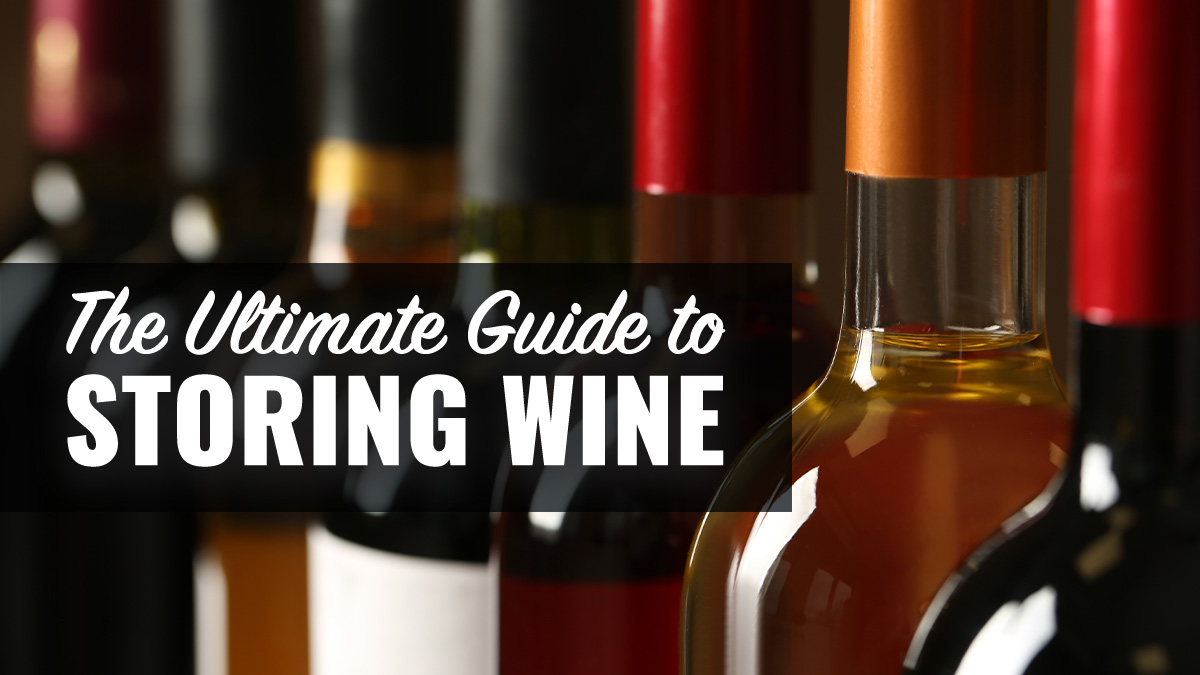
What happens with that nice bottle of wine you bought but that you may not want to drink right away? What should you do about that bottle that you may not want to drink for several weeks or months? Perhaps you’re caring for a handful of bottles or managing a larger collection, either way, it’s crucial to preserve their quality.
In this blog, you’ll find guidelines for how to store wine, and, along the way, hopefully you’ll get some good rules of thumb to remember when storing your wine.
To begin with, the ideal way to store wine is a private wine cellar. While a dedicated wine cellar is a luxury that many people do not have, it’s important to know how cellars work since they are the ideal setting for wine storage. It’s also possible to replicate the effects of a wine cellar for your personal wine collection depending on how you choose to store it. Understanding cellars and other proper storage techniques will help to ensure your wine remains in peak condition until it’s time to be uncorked and enjoyed.
What’s the Optimal Temperature for Storing Wine?
Temperature control is the fundamental aspect of wine cellar management. It’s important to note that the ideal storage temperature for wine is often different from the ideal serving temperature, which varies depending on the type of wine you’re enjoying. There are two critical factors when setting your cellar temperature.
Average Temperature
The baseline temperature for your cellar, especially if you’re planning a passive cellar (one without cooling devices), should be around 55°F (13°C). This is considered the optimum storage temperature for most wines. Keep in mind that a range of about 45°F to 65°F is generally acceptable for long-term storage, provided there aren’t significant daily fluctuations in temperature. Wines stored at the warmer end of this range may age slightly faster, whereas those kept at the cooler end might develop harmless tartrate crystals around the cork or near the bottom of the bottle. These crystals, while having no effect on the wine’s quality, can be minimized by keeping your cellar temperature closer to the middle of the range.
Temperature Variation
Consistency is essential when it comes to the temperature of your cellar. Fluctuations within a few degrees over several months are generally considered harmless, but your wine will quickly degrade with daily shifts of 5-8°F. These kinds of variations can cause the wine to expand and contract, which may lead to oxidation and other forms of spoilage that can significantly alter the taste and integrity of the wine.

What Are Some Practical Tips for Wine Storage?
Here are a few things to consider when planning how to store wine that will ensure the quality and flavor of your wine until you’re ready to enjoy it.
Location: Select a location for your wine storage that naturally maintains a secure, balanced temperature year-round. Basements are usually the best place to provide these conditions and are also away from direct sunlight and the fluctuating household temperatures.
Insulation: Make sure your storage area has proper insulation that can help stabilize temperatures and reduce the effect of external temperature variations.
Monitoring: Regularly monitor the temperature of your cellar with a reliable thermometer to ensure it remains within the desired range.
Professional Solutions: If you’re serious about wine collection, consider investing in a professional wine cellar cooling system, which can provide precise temperature control.
By adhering to these guidelines, you can create an ideal environment for storing wines, enhancing their maturation process and preserving their distinct characteristics and flavors for optimal enjoyment upon opening.
Can I Store My Wine In My Household Refrigerator?
Storing wine in a regular household refrigerator for a short time – from a few weeks to a couple of months – might be all right, but it’s far from ideal for extended periods. Normal refrigerators are designed to maintain temperatures well below 45°F to preserve perishable foods, which is significantly colder than the ideal temperature range for storing wine. More importantly, the lack of humidity in the typical kitchen refrigerator will not sufficiently keep corks moist. This dry environment can lead to shrinkage of the cork, this allows air to enter the bottle and possibly spoil the wine. Observe an uncovered tomato in your fridge and how it shrivels up due to the lack of humidity, so too can a dry cork contribute to the degradation of wine, which leads to musty, “corked” flavors.
It’s also necessary to avoid places where wine might freeze, such as an unheated garage during winter or placing it in the freezer to chill quickly and accidentally leaving it there. When wine freezes, the expanding liquid forces the cork out, which risks exposure and spoilage.
Is It Safe To Store My Wine On Top Of The Refrigerator?
The placement of your wine inside your home (not in the basement) matters significantly. Many people place their wine on top of the refrigerator. This location is unwise due to three main harmful factors:
Heat Emission: In order to keep the inside cool, the fridge uses a compressor and other working components that emit heat around its exterior. This raises the temperature around the top of the fridge where bottles are often placed. This warmth can speed up the aging process of your wine, potentially harming its integrity.
Light Exposure: When stored on top of the fridge, your wine runs the risk of being positioned near light fixtures and the exposure to these fixtures can be harmful. Light, particularly from bulbs that emit a significant amount of heat, prematurely ages wine, affecting its flavor and freshness.
Vibrations: The refrigerator’s compressor, ice maker, and other parts can cause vibrations that disturb the wine’s aging process and can change its chemical structure, affecting its taste. (More on vibrations below.)
The top of a refrigerator, while convenient and seemingly a good option, is one of the worst places to store wine due to the combination of these factors. As an option, consider investing in a wine refrigerator, which maintains a secure temperature and humidity level specifically designed for storage of wine. This dedicated environment helps preserve your wine’s flavor and quality over time, ensuring that each bottle matures as intended without suffering from improper storage conditions.
Should I Use A Dark Or Light Room for Wine Storage?
Light, sunlight in particular, poses a significant risk to long-term wine storage. Sunlight’s ultraviolet (UV) rays have the potential to degrade and prematurely age wine – this is why vintners often use colored glass bottles. These tinted bottles function like sunglasses, offering protection from the sun’s damaging rays. Though the normal household bulb does not generally pose the same risk to the wine’s quality, they can have an adverse effect on labels, causing them to fade over time. Of all the household light options, incandescent bulbs are likely the safer bet over fluorescent bulbs, as the latter emit small amounts of UV light.
In an effort to avoid any deterioration in the quality of your wine, darkness is the preferred condition for storage. Exposure to light in any form can lead to the development of unwanted flavors and aromas in wine. This is another reason behind the preference for darkly tinted bottles, typically in shades of brown and green, which are best for protection. If your storage area includes lighting, it should remain off and only used when selecting a bottle, doing inventory, or showing off your collection to friends. Direct sunlight should be avoided at all costs so that your wine remains in immaculate condition, preserving its flavors and extending its integrity.
What About Humidity and Wine Storage?
Maintaining the right humidity level is crucial for proper wine storage. The optimal humidity range for storing wine is considered by most to be in the range of 60% to 80%. Once the levels get below 55%, there’s a risk of drying out the corks. This can compromise the seal, which may lead to the complete oxidation of the wine. On the other hand, if humidity levels rise above 80% the conditions become ideal for the promotion of mold growth. While well-sealed wine may not directly be affected, high humidity can damage the labels and introduce unpleasant odors into your storage area. Experts suggest aiming for about 70% humidity to prevent these issues. At this level the corks are more likely to remain moist enough to maintain their integrity without allowing air into the bottle, which could spoil the wine.
For those not living in the extreme end of either dry or damp conditions, maintaining this level of humidity is not difficult. If you test your area for a period of a few days and find that it is too dry, try placing a pan of water in the space which can help increase humidity. Conversely, if conditions are too damp, using a dehumidifier can help protect both your wine and its labels from damage related to issues with moisture. By keeping an eye on your storage area’s humidity levels and adjusting as needed, your wine collection can remain well protected.

Should Wine Be Stored Upright Or On Its Side?
Storing wine in the correct position is imperative for maintaining its quality, flavor, and aroma in a fashion that the winemaker intended. There are a few options to consider when planning how to store wine, each with its strengths and weaknesses.
Horizontal Storage
The best way to store wine is horizontally, which keeps the liquid in contact with the cork. This allows the cork to remain moist and swelled, which is key for preventing air from entering the bottle, which leads to oxidation. Oxidation can alter the wine’s taste and cause spoilage. Horizontal racks also create the natural settling of sediments along the side of the bottle; an important effect for aging wines as it prevents them from becoming gritty or cloudy. In addition to helping preserve the wine, this method also allows for an aesthetically pleasing display of your collection since the labels are easily visible. Wine racks built for horizontal storage can be adapted to various installation needs, including wall-mounted, countertop, tabletop, or floor setups, which makes them multifaceted additions to any space.
Tilted Storage
Some wine collectors prefer tilted racks as opposed to horizontal storage. It’s important that tilted racks have only a slight incline, enough to keep the cork moist yet impede sediment from collecting near the bottle’s neck, which can happen if the tilt is too steep. While the horizontal racks are ideal, tilted racks are a decent storage solution, particularly when space constraints prevent the implementation of horizontal racks.
Vertical Storage
Vertical storage is the least favorable for long-term preservation and should only be used for short periods or for display purposes. While standing upright, the wine does not touch the cork. This can dry out the cork and lead to exposure to air, allowing for potential spoilage issues due to oxidation. However, vertical racks are beneficial for featuring bottles during events or in a retail environment where bottles are often sold and consumed quickly. It’s important to note that wines sealed with screw caps or various non-cork seals may be stored vertically without the risk of oxidation, since these closures do not rely on moisture from the wine to stay effective.
Storage Solutions
For those serious about wine collection, it’s wise to consider investing in specialized storage solutions such as wine cellars, wine cabinets, or wine refrigerators. These options are designed specifically to maintain the ideal environment for wine, allowing for temperature, humidity, and other factors to be kept within optimal ranges. Wine cabinets and refrigerators offer convenience and are suitable for both residential and commercial settings. They ensure that your wine collection is secure with easy-to-manage conditions that help preserve its integrity and enhance its aging opportunity.

What Are Vibrations And What Do I Need To Know About Them?
Vibrations are that third “top of the fridge” storage issue that deserves a closer look since they occur in other environments that only the top of the refrigerator. More powerful vibrations, such as those from trains nearby or loud musical performances that take place near you, might disturb the sediment in aged wines, preventing it from settling properly and leading to a gritty texture. For most settings, these types of disturbances are unlikely to impact short-term wine storage. And remember: never forcefully shake a bottle of wine as one might with champagne.
The impact of vibrations should not be underestimated when considering different options for wine storage, particularly when storing wine for extended periods. If you’re purchasing a refrigerated wine cabinet, make certain that it features a motor that is effectively isolated to prevent the wine from being affected by any vibrations. If you’re building a wine cellar, select an area that has limited exposure to vibrations. Keep in mind that transporting wine via an airplane might temporarily alter its taste due to the intense vibrations, but it usually returns to normal after a few days of settling once travel is complete.
How Do Odors Affect My Stored Wine?
Strong odors – such as mold, cleaning chemicals, ammonia, or other pungent substances – can impact your wine. The cork, being porous, may absorb these odors and possibly transfer them to the wine. While it’s not necessary to be too concerned about this happening, it’s a good rule of thumb that if you smell an unpleasant scent in the space you’re in with your wine, remember that odor could also negatively affect the wine. Consider maintaining a neutral-smelling environment in your storage area to ensure the integrity of your wine’s flavor.
Enjoy Your Wine!
“Wine is bottled poetry” said Robert Louis Stevenson, and now, equipped with these tips on wine storage, you can treat it as such. Diligent attention and care for your collection will help maintain its quality and preserve the delicate balance and true character of your cherished wine. So raise your glass to the grape, and enjoy your properly stored wine at its very best, as it was intended.
The ideal temperature for storing wine is between 45°F and 65°F (7°C to 18°C). Consistent temperature is more critical than the exact degree.
Wine with cork closures should be stored on its side to keep the cork moist and prevent it from drying out, which could lead to oxidation.
Humidity levels should be between 50% to 80% to prevent corks from drying out and minimize the risk of mold growth. Too low humidity can dry out corks, while too high humidity can encourage mold.
If you don’t have a wine cellar, store wine in a cool, dark place with stable temperatures, such as a closet or basement. Avoid storing wine in areas prone to temperature fluctuations, like kitchens or near heating sources.
While a refrigerator can be used for short-term storage of white and sparkling wines, it’s too cold for long-term storage of red wines and can dry out corks if kept upright for extended periods.
Most wines can be stored for a few days to a week after opening if properly re-corked and refrigerated. However, fortified wines like Port or Madeira can last longer due to their higher alcohol content.
Yes, prolonged exposure to light, especially UV light, can degrade wine and cause off-flavors. Store wine in a dark place or in opaque containers to protect it from light exposure.
Yes, wines sealed with natural cork should be stored on their sides to keep the cork moist. Wines with synthetic or screw cap closures can be stored upright.
Yes, a wine cooler or refrigerator is an excellent option for short to medium-term wine storage, providing consistent temperature and humidity levels.
Organize your wine collection by type, vintage, or region to make it easier to locate specific bottles. Consider using a wine inventory system to track your wines.
While cardboard boxes can offer some protection from light, it’s not ideal for long-term storage due to the risk of temperature fluctuations and potential exposure to pests or moisture.
No, wine can absorb odors from its surroundings, which can affect its flavor and aroma. Store wine away from strong-smelling substances like chemicals, spices, or cleaning products.
Yes, the storage area’s location can impact wine storage due to factors like temperature, humidity, and exposure to light and vibrations. Choose a cool, dark, and stable environment for optimal storage conditions.
Wine racks are a convenient way to store and display wine bottles, but they should be placed in a suitable environment to maintain proper storage conditions, such as a cool, dark room.
Yes, wine bottles can be stored horizontally without a wine rack as long as they are stable and won’t roll around. Placing bottles on their sides helps keep corks moist and prevents oxidation.
Choose a storage location with minimal temperature fluctuations, such as a basement or wine cooler. Avoid storing wine near heat sources or in areas prone to temperature swings.
Storing wine bottles at a slight angle can help keep the cork moist, but it’s not necessary if the bottles are stored horizontally. Ensure that the cork remains in contact with the wine to prevent drying out.
Yes, as long as the wooden cabinet or shelf provides a stable environment with consistent temperature and humidity levels. Avoid storing wine in areas prone to temperature fluctuations or excessive humidity.
Store wine away from sources of vibration, such as appliances, machinery, or heavy foot traffic areas. Choose a stable location with minimal vibration to protect wine during storage.
If you suspect your wine has been stored improperly, inspect the bottles for any signs of damage, leakage, or off-flavors. Consider consulting a wine professional for guidance on whether the wine is still suitable for consumption.




